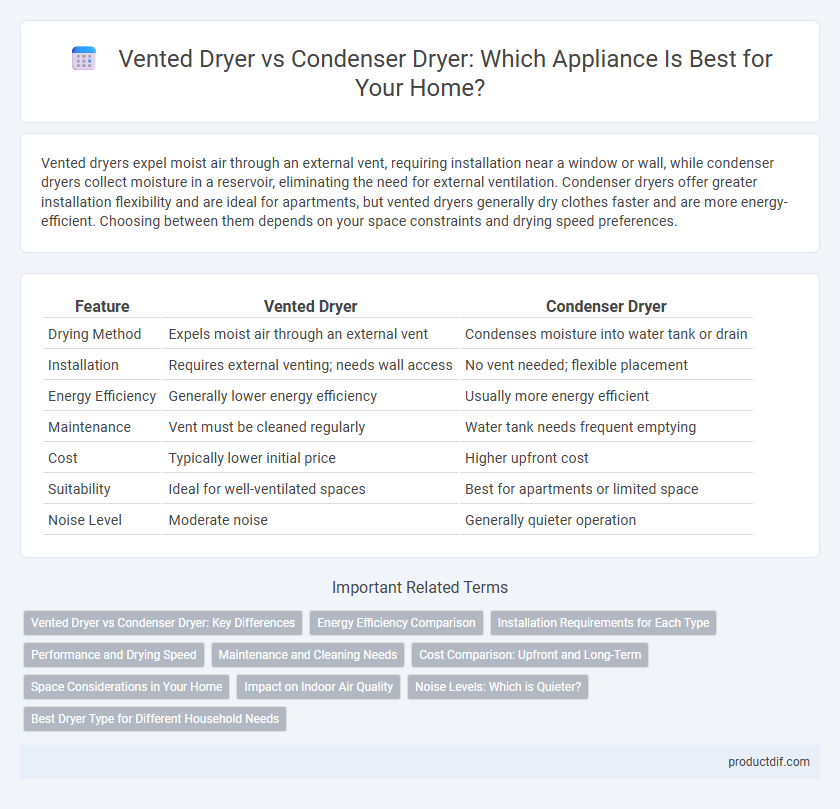Vented dryers expel moist air through an external vent, requiring installation near a window or wall, while condenser dryers collect moisture in a reservoir, eliminating the need for external ventilation. Condenser dryers offer greater installation flexibility and are ideal for apartments, but vented dryers generally dry clothes faster and are more energy-efficient. Choosing between them depends on your space constraints and drying speed preferences.
Table of Comparison
| Feature | Vented Dryer | Condenser Dryer |
|---|---|---|
| Drying Method | Expels moist air through an external vent | Condenses moisture into water tank or drain |
| Installation | Requires external venting; needs wall access | No vent needed; flexible placement |
| Energy Efficiency | Generally lower energy efficiency | Usually more energy efficient |
| Maintenance | Vent must be cleaned regularly | Water tank needs frequent emptying |
| Cost | Typically lower initial price | Higher upfront cost |
| Suitability | Ideal for well-ventilated spaces | Best for apartments or limited space |
| Noise Level | Moderate noise | Generally quieter operation |
Vented Dryer vs Condenser Dryer: Key Differences
Vented dryers expel moist air through a hose requiring external ventilation, making them suitable for well-ventilated spaces and typically more energy-efficient with shorter drying times. Condenser dryers collect moisture in a reservoir or direct it to drainage, allowing installation without external vents but generally consuming more energy and taking longer to dry clothes. Choosing between vented and condenser dryers depends on available space, ventilation options, and energy considerations.
Energy Efficiency Comparison
Vented dryers typically consume more energy because they expel hot, moist air outside, requiring continuous heating, while condenser dryers recycle and condense air internally, improving energy efficiency. Condenser dryers with heat pump technology use significantly less electricity, reducing overall energy consumption by up to 50% compared to traditional vented models. Choosing a condenser dryer can lead to lower utility bills and a smaller environmental footprint due to its optimized energy use.
Installation Requirements for Each Type
Vented dryers require a direct external vent to expel moist air, necessitating proximity to an exterior wall and proper ducting for installation. Condenser dryers operate by condensing moisture inside the unit, allowing installation without external vents and offering greater flexibility in appliance placement. Proper adherence to manufacturer guidelines for ventilation and drainage is crucial to maintain efficiency and avoid moisture damage in either system.
Performance and Drying Speed
Vented dryers expel moist air outside, resulting in faster drying times by quickly removing humidity from clothes; they are highly effective in well-ventilated spaces. Condenser dryers recycle air by condensing moisture into a water tank, which slows drying speed but allows placement anywhere without external venting. Performance varies as vented models typically handle larger loads more efficiently, while condenser dryers offer versatility with slightly longer cycle durations.
Maintenance and Cleaning Needs
Vented dryers require regular cleaning of the exhaust vent to prevent lint buildup and ensure efficient airflow, reducing fire hazards. Condenser dryers need frequent emptying and cleaning of the water reservoir and condenser unit to maintain optimal performance and avoid mold growth. Both types benefit from routine lint filter cleaning after each use to enhance drying efficiency and appliance longevity.
Cost Comparison: Upfront and Long-Term
Vented dryers typically have a lower upfront cost, making them more affordable for initial purchase compared to condenser dryers. However, condenser dryers often result in higher long-term energy bills due to less efficient moisture removal, which can increase electricity consumption. Considering maintenance expenses, vented dryers may require regular duct cleaning, while condenser dryers demand periodic water reservoir emptying and filter cleaning, impacting overall operational costs.
Space Considerations in Your Home
Vented dryers require an external vent to expel hot, moist air, necessitating a dedicated wall or window space, which may limit placement options in small or interior rooms. Condenser dryers collect moisture in a reservoir or drain it away, eliminating the need for external venting and offering greater flexibility for installation in apartments or areas without outside walls. Choosing a condenser dryer maximizes space efficiency in compact living environments, while vented dryers may demand additional structural considerations for proper vent placement.
Impact on Indoor Air Quality
Vented dryers expel moist air and lint outside through a duct, which can reduce indoor humidity but may require proper vent installation to prevent outdoor pollutants from entering. Condenser dryers collect moisture in a tank or drain it away, avoiding the need for external venting but potentially increasing indoor humidity and affecting air quality if the room is not well-ventilated. Choosing between these appliances impacts indoor air quality by balancing moisture control and air exchange efficiency.
Noise Levels: Which is Quieter?
Vented dryers generally produce lower noise levels compared to condenser dryers due to their simpler airflow system that expels air outside, reducing internal vibrations. Condenser dryers use a heat exchanger and a water collection system, which can generate additional mechanical noise during operation. Consumers seeking quieter laundry appliances often prefer vented dryers for their reduced sound output.
Best Dryer Type for Different Household Needs
Vented dryers efficiently expel moisture through an external vent, making them ideal for households with ample outdoor access and quick drying needs, while condenser dryers condense moisture internally, offering flexibility for spaces without venting options, like apartments. Condenser dryers are better suited for environments where installation of external vents is impractical, despite typically longer drying cycles and higher energy consumption. Choosing the best dryer type depends on space availability, drying speed preferences, and installation constraints to optimize household efficiency.
Vented dryer vs Condenser dryer Infographic

 productdif.com
productdif.com